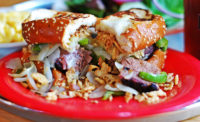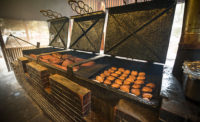Barbecue is everywhere and in all different meat and poultry forms and sauces, but it all starts with low-and-slow or grilled. It’s no surprise barbecue ranked in the top five perennial favorites of the nearly 1,300 chefs surveyed for the National Restaurant Association’s What’s Hot 2017 Culinary Forecast. A quarter of these chefs even labeled barbecue a hot trend.
Barbecue items, including barbecue sauce, are found at 59 percent of restaurants, reports Datassential, in Chicago. This has held steady since 2005 with little decline or growth.
Menu Insights from Mintel International, also in Chicago, confirms the instances of barbecue items on menus is relatively flat, but looking at specific menu items, barbecue pizza is up 4 percent, barbecue poultry grew 2 percent and barbecue beef increased 8 percent. Caleb Bryant, a Mintel foodservice analyst, feels barbecue beef may be up due to the lower prices the industry is experiencing.
“Consumers really crave that authenticity, and that authenticity is often present within barbecue restaurants,” he says. “We think that having a barbecue restaurant with an open kitchen to see where they are actually cooking or smoking the meats really conveys that authenticity to customers.”
Linda Orrison, president of the National Barbecue Association (NBBQA), in Naperville, Ill., agrees barbecue is doing well because people are looking for purer proteins.
“People want to know what they are eating, where it came from and how it is grown,” she says. “Two or three generations ago, we didn’t have those questions, because grandpa went out and he got the cow or pig and he cooked it. These are legitimate concerns, [and] the barbecue industry is the one that can answer these questions far more than a lot of food-related industries.”
Barbecue trends in restaurants
Demand is up double-digits for smoked sausage (19 percent), beef brisket (12 percent) and beef ribs (16 percent) at dinnertime, according to the Chicago-based Technomic Inc.’s 2017 Centre of the Plate: Beef and Pork Consumer Trend Report. In turn, brisket has become a big trend in restaurants, says Pat Cobe, Technomic’s senior editor, menu.
“People are not just using brisket as a standalone barbecue item, but they are putting it on burgers and flatbread, so they are using barbecue brisket as an add-on,” she explains.
For example, several quick-service restaurants are offering brisket, if even for limited-time offerings. Schlotzsky’s Deli, for instance, offers a Spicy Brisket Flatbread and Italian Shrimp and Brisket Flatbread, both featuring hickory-smoked brisket. Qdoba offers its Habanero BBQ Brisket in items such as Loaded Tortilla Soup, 3-Cheese Nachos, Taco Salad, Tacos and Quesadillas. Bruegger’s Bagels offered two barbecue items for a limited time: Breakfast Brisket, pairing its brisket with egg, Muenster cheese, pickled onions and horseradish sauces on a toasted Everything Bagel, and a Twisted Brisket, featuring bacon, Muenster cheese and Dijonnaise sauce on toasted jalapeno cornbread. Arby’s also still offers its Smokehouse Brisket sandwich and has tested a brisket biscuit for breakfast.
Barbecue has recently begun to make its way onto breakfast menus as other lunch and dinner flavors also are moving into that daypart, says Claire Conaghan, senior account manager at Datassential. Barbecue is up 14 percent on breakfast menus during the past year, the research firm reports.
“Just 6 percent of restaurants with breakfast offer an item with barbecue, but major midscale chains are starting to add things like pulled pork omelets and brisket hashes to their menu,” Conaghan says. “Consumers rate these items as highly unique, and they still have fairly high purchase intent with at least half of consumers interested in purchasing.”
One trend Conaghan sees looking at sandwiches and center of plate is beef, pork and chicken are including barbecue as a flavor more. More menus also are titling their dishes with pork as being “pig,” a term that’s up more than 42 percent during the past year, she adds.
Both barbecue pulled pork and barbecue brisket were up on menus this past year in restaurants, 9 percent and 6 percent, respectively, Datassential finds.
Of the different barbecue styles, Korean continues to grow, with Korean barbecue now found on 2 percent of all menus up 24 percent during the past year and 153 percent, during the past four years, Datassential says. Restaurants also rarely call out domestic regional flavors, Conaghan says, though often restaurants will describe the sauce flavors that are associated with the regions, such as tangy, mustardy or sweet.
Mintel Menu Insights data also finds geographical claims fairly flat, but more limited-time offerings are highlighting regional claims, such as Kentucky Fried Chicken’s Nashville Hot Chicken and Georgia Gold Chicken.
On the other hand, Mintel Menu Insights data finds instances of sweet as an ingredient in barbecue, such as in “sweet barbecue sauce,” is up 10 percent. For example, Pollo Tropical offers a Guava BBQ Pork Sandwich, served with a sweet and tangy Guava BBQ Sauce.
Instances of spicy in regard to barbecue are also up 10 percent and spice is up 4 percent, Mintel Menu Insights data reports.
“We are just seeing more consumers are open to spicier flavors, and operators are leveraging spicier flavors on their menus,” Bryant says.
For international trends, it is no surprise that Korean barbecue seems the most promising. “Korean barbecue sauce is something different, but it’s not so entirely out there that some consumers are totally turned off by it,” Bryant says. “As those Korean flavors become a bit more mainstream, I expect to see more consumers trying out more authentic Korean foods or flavors.”
Barbecue pork shows up in several trending ethnic preparations and street foods, which are being adapted for restaurants and foodservice locations in colleges and universities along with corporate cafeterias, Technomic’s Cobe says. For example, Korean barbecue and barbecue pulled pork are appearing on street tacos as well as carnitas — which is traditionally made by braising pork — and tacos al pastor, which typically is made with shawarma spit-grilled pork. For example, Pancheros Mexican Grill offers carnitas and tacos al pastor and Korean BBQ Street Tacos are available at California Tortilla.
In addition, barbecue pork traditionally appears in Vietnamese sandwiches, and, for a limited time, Which Wich offered a Bánh Mì featuring pulled pork. Filipino cuisine, such as Filipino lechon in which a whole pig is roasted, also is emerging. Filipino cuisine uses a lot of pork and includes nose-to-tail cooking, Cobe says. Filipino cuisine also has the potential to become more mainstream with Jollibee, the largest fast-food chain in the Philippines, opening more locations in the United States.
NBBQA’s Orrison also sees people are learning to try other flavors in the meat, especially ethnic flavors. “This will dramatically expand the thinking and the acting of the modern pitmaster to bring these ethnic dishes and different types of the proteins to the table,” she says.
Orrison also believes we will continue to see more diversity in the standard barbecue palate. “The Millennial generation is growing up with small barbecue joints in non-typical locales like Brooklyn, Chicago, San Diego, so barbecue right now is white-hot, and we are going to continue to see that for several years to come,” she says.
Of the domestic flavors, Southern cuisine is becoming more regionalized, and people are exploring its niches, such as Appalachian cuisine, Cobe says.
Mary Stebbins, director of operations for Mark’s Feed Store, in Louisville, Ky., agrees people’s palates are maturing for barbecue. “We are seeing more locally chef-owned restaurants, which are driving more creativity and a twist to the standard menu,” she says. “People’s palates are also trending to country and Southern-style foods.”
Stebbins actually sees all styles of barbecue growing as the barbecue trend continues to grow. “Sometimes the biggest difference in the style of barbecue is the sauces offered,” she says. “Everyone is creating their own unique flavor of barbecue sauce. At times that is the biggest difference maker.”
Bryant Anderson, executive chef at sister restaurants Kinfork, in Schaumburg, Ill., and Rack House Kitchen and Tavern, in Arlington Heights, Ill., agrees people used to travel to Texas or Memphis for smoked meats but now, due to the evolution of American palates, smoked meats and barbecue are in demand in cities all over the country.
“Carolina barbecue sauces, which are heavy on the vinegar, are gaining popularity in the North,” he says. “The vinegar-based sauces help cut through the fatty richness of the smoked pulled pork, and Texas brisket, slow smoked over coals and hickory logs, is very popular in Chicago.”
One of the hottest trends in the culinary scene right now is “smoked meats,” Anderson says.
“Everyone wants to eat or prepare the next best thing, but something as tried and true as good old-fashioned smoked meats has been and will remain one of the hottest trends in the culinary scene,” he says. “People like smoked meats. They think it’s cool and unique, and since most people don’t have the know-how to prepare it, they will pay for it at a smokehouse.”
With new technologies and more home smokers offered and more Food Network and Travel Channel shows focused on barbecue cooking and competitions, the industry is seeing that many more people are trying to turn their home hobby into a dream of opening a barbecue restaurant or some are hitting the now-popular food truck scene, Stebbins says.
“Some of the fine-dining chefs that have turned to barbecue cooking are introducing new meats such as Wagu beef, etc., versus the traditional meats,” she adds. “The most popular item — but the hardest to [perfect] — is brisket. Everyone is trying for the perfect brisket.”
Mark’s Feed Stores sees ribs as its most popular dish, as is its burgoo, which is similar to a hearty stew. Other popular dishes include smoked pork or chicken and Mark’s Famous Honeywings. At Kinfork and Rack House, one of its specialties is brisket burnt ends.
“This is the point of the brisket, and we smoke it for 10 hours at a higher temperature than our whole briskets,” Anderson explains. “This results in a charred, burnt crust forming all over the meat. It is served with our balsamic barbecue sauce and house pickles.”
Oak Smoked Chicken Wings are also very popular at these restaurants. “We won first place at a local wing fest in 2016, and we sell hundreds of pounds of smoked chicken wings a week.”
Barbecue demands at retail
At home, consumers are enjoying barbecue as a change of pace from the usual dinner items.
“Precooked/heat-and-eat barbecue products are convenient for consumers to prepare at home and make it easy to enjoy restaurant-style food right at home,” says Eric Jacobson, brand manager, meat products marketing at Hormel Foods, in Austin, Minn. Dedra Berg, director of marketing for fresh pork at Smithfield Foods, in Kansas City, Mo., agrees convenience and flavor are paramount.
“We know our customers are always looking for easy, simple meals that require minimal tools and clean-up, but are still packed with delicious flavor,” she says. “Because fresh pork is so versatile and pairs well with bold flavors, it’s the perfect go-to for any barbecue recipe. At Smithfield, we offer a variety of barbecue-flavored pre-marinated fresh pork cuts, including Slow Smoked Mesquite Fresh Pork Tenderloins and Loin Filets, Southwest Style Peppercorn Dry Seasoned Ribs and more, making it easy for our customers to achieve a restaurant-quality meal right at home.”
Pork, whether ribs or pulled/shredded, continue to be the go to meat for barbecue, Hormel’s Jacobson says. The regional tie-in that barbecue features is something Hormel believes also will resonate with consumers.
“Kansas City, Memphis, Texas or Carolina, these regions are known for their particular styles of barbecue meat and sauces,” Jacobson says. “They make it easy for consumers to be able to enjoy different flavors and to identify their preferred style. Also connecting to the traditional barbecue regions brings a sense of authenticity to barbecue products.”
During the past year, Hormel has focused on its core product line, and Jacobson says the company’s Baby Back Ribs with Lloyd’s Original BBQ sauce continues to gain traction with consumers.
“They love the super meaty ribs and sweet barbecue sauce that has remained unchanged over the years; it has become a perennial favorite,” he says. “We are expecting the category to continue to grow in 2017, as consumers reignite their passion for barbecue.”
Smithfield hasn’t seen one style of barbecue stand out in the past year, but the company has seen a growth in the fresh pork ribs category in particular.
“Not only do we work with pitmasters from all different regions who use Smithfield Prime and Extra Tender Fresh Pork Ribs in competitions, but we also offer Southwest Style Peppercorn, Carolina, Memphis or Kansas City Style BBQ Dry Seasoned Ribs for the at-home cook,” Berg says.
With more Americans owning an outdoor barbecue grill or smoker and the majority of using them year round, Smithfield is launching a number of “Great on the Grill” Fresh Pork products within its Smithfield Marinated portfolio, including Hickory Smoked Brown Sugar and Roasted Garlic & Herb Pork Chops. These dry-seasoned cuts can be prepared in 30 minutes or less, the company says. With the continued increase in both usage and purchase of smokers and grills, as well as the expanding number of TV shows and online searches around barbecue, Berg continues to see barbecue becoming a true lifestyle activity.
“We expect tremendous growth not only for barbecue pork products, but competition barbecue cuts, which include pork ribs, pork butt, brisket and chicken thighs,” she says. “In fact, these barbecue cuts are growing seven times faster than the total fresh meat category.”
Growing barbecue
With barbecue a favorite flavor and item, innovation and growth needs to come from new item types or flavor varieties.
“Expansion to breakfast is one such option,” says Datassential’s Conaghan. “For flavors, look to other countries such as for Korean barbecue or consider combo flavors of top-growing flavor options such as a sriracha barbecue.”
One trend Kinfork and Rack House’s Anderson knows that will positively affect smoked meats is the “brining and curing” of meats — for example, brining beef briskets to make homemade smoked pastrami, or brining and curing pork bellies to make homemade smoked bacon.
“This is a trend you will start to see pop up around the country soon,” he says. “I expect barbecue to continue to grow and become widely accepted as a top culinary preparation technique.”
Technomic’s Cobe believes restaurants should focus on appetizers to keep barbecue growing. “People are eating smaller portions of meat, and appetizers are a good way to get a smaller portion,” she says.
In the future, Mintel’s Bryant expects to see more fast-casual barbecue-specific restaurants. He also would look at Korean barbecue as being a trendy different offering, along with more chain restaurants featuring barbecue limited-time offerings.
To keep barbecue growing, Bryant believes restaurants need to focus on unique flavors and spicier flavors if their consumers are open to them. “Also I think that authenticity is very important,” he says. “Consumers really want authentic foods, but they also want freshness. So doing something in house like smoking meats and cooking everything to order is something definitely to focus on.” NP






Report Abusive Comment